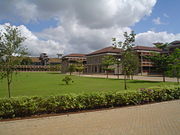Nairobi
2008/9 Schools Wikipedia Selection. Related subjects: Africa; Cities
| Nairobi, Kenya | |||
| Nairobi Skyline | |||
|
|||
| Location of Nairobi | |||
| Coordinates: | |||
|---|---|---|---|
| Country | Kenya | ||
| Province | Nairobi Province | ||
| HQ | City Hall | ||
| Founded | 1899 | ||
| Constituencies of Nairobi |
List
|
||
| Government | |||
| - Mayor | Geoffrey Majiwa | ||
| Area | |||
| - City | 684 km² (264.1 sq mi) | ||
| Elevation | 1,661 m (5,450 ft) | ||
| Population (2007) | |||
| - City | 2,940,911 | ||
| - Density | 4,230/km² (10,955.6/sq mi) | ||
| - Urban | 3 million | ||
| - Metro | 4 million | ||
| Time zone | EAT ( UTC+3) | ||
| Website: http://www.nairobicity.org/ | |||
Nairobi (pronounced /naɪˈroʊbɪ/) is the capital and largest city of Kenya. The name "Nairobi" comes from the Maasai phrase Enkare Nyirobi, which translates to "the place of cool waters". However, it is popularly known as the "Green City in the Sun."
Founded in 1899, the city was handed capital status from Mombasa in 1905. Nairobi is also the capital of the Nairobi Province and of the Nairobi District. The city lies on the Nairobi River, in the south of the nation, and has an elevation of 1661 m (5450 ft) above sea-level.
Nairobi is the most populous city in East Africa, with an estimated urban population of between 3 and 4 million. According to the 1999 Census, in the administrative area of Nairobi, 2,143,254 inhabitants lived within 684 km². Nairobi is currently the 4th largest city in Africa.
Nairobi is now one of the most prominent cities in Africa politically and financially. Home to many companies and organizations, Nairobi is established as a hub for business and culture. The Globalization and World Cities Study Group and Network ( GaWC) defines Nairobi as a prominent social centre.
History
The area was an essentially uninhabited swamp until a supply depot of the Uganda Railway was built in 1899, which soon became the railway's headquarters. The city was named after a water hole known in Maasai as Ewaso Nyirobi, meaning "cool waters." It was totally rebuilt in the early 1900s after an outbreak of plague and the burning of the original town. The location of the Nairobi railway camp was chosen due to its central position between Mombasa and Kampala. It was also chosen because its network of rivers could supply the camp with water, and its elevation would make it cool enough for residential purposes. Furthermore, at 1661 metres above the sea level the temperatures are too low for the malaria mosquito to survive.
In 1905, Nairobi replaced Mombasa as capital of the British protectorate, and the city grew around administration and tourism, initially in the form of big game hunting. As the British colonialists started to explore the region, they started using Nairobi as their first port of call. This prompted the colonial government to build several spectacular grand hotels in the city. The main occupants were British game hunters.
Nairobi continued to grow under the British rule, and many Britons settled within the city's suburbs. The continuous expansion of the city began to anger the Maasai, as the city was devouring their land to the south. It also angered the Kikuyu people, who wanted the land returned to them.
In 1919, Nairobi was declared to be a municipality. In February 1926, E.A.T. Dutton passed through Nairobi on his way to Mount Kenya, and said of the city:
Maybe one day Nairobi will be laid out with tarred roads, with avenues of flowering trees, flanked by noble buildings; with open spaces and stately squares; a cathedral worthy of faith and country; museums and galleries of art; theatres and public offices. And it is fair to say that the Government and the Municipality have already bravely tackled the problem and that a town-plan ambitious enough to turn Nairobi into a thing of beauty has been slowly worked out, and much has already been done. But until that plan has borne fruit, Nairobi must remain what she was then, a slatternly creature, unfit to queen it over so lovely a country.
– Dutton,
After the end of World War II, this friction developed into the Mau Mau rebellion. Jomo Kenyatta, Kenya's future president, was jailed for his involvement even though there was no evidence linking him to the rebellion. Pressure exerted from the locals onto the British resulted in Kenyan independence in 1963, with Nairobi as the capital of the new republic.
After independence, Nairobi grew rapidly and this growth put pressure on the city's infrastructure. Power cuts and water shortages were a common occurrence, though in the past few years better city planning has helped to put some of these problems in check.
The U.S. Embassy in Nairobi was bombed in August 1998 by Al-Qaida, as one of a series of U.S. embassy bombings. Over two hundred civilians were killed. It is now the site of a memorial park.
Geography
The city is located at and occupies 684 square kilometres (260 sq mi). It is situated 1661 metres (5450 ft) above sea level.
Nairobi is situated between the cities of Kampala and Mombasa.As Nairobi is adjacent to the eastern edge of the Rift Valley, minor earthquakes and tremors occasionally occur. The Ngong hills, located to the west of the city, are the most prominent geographical feature of the Nairobi Area. Mount Kenya is situated north of Nairobi and Mount Kilimanjaro is towards the south-east. Both mountains are visible from Nairobi on a clear day.
The Nairobi River and its tributaries traverse through the Nairobi Province. Nobel Peace Prize laureate Wangari Maathai has fought fiercely to save the indigenous Karura Forest in northern Nairobi which was under threat of being replaced by housing and other infrastructure.
Nairobi's western suburbs stretch all the way from the Kenyatta National Hospital in the south to the UN headquarters and Gigiri in the north, a distance of about 20 kilometres (12 mi).
The city is centred on the City Square, which is located in the Central Business District. The Kenyan Parliament buildings, the Holy Family Cathedral, Nairobi City Hall, Nairobi Law Courts and the Kenyatta Conference Centre all surround the square.
Climate
At 1,661 metres (5,449 ft) above sea level, Nairobi enjoys a fairly moderate climate. The altitude makes for some chilly evenings, especially in the June/July season when the temperature can drop to 10 °C (50 °F). The sunniest and warmest part of the year are from December to March, when temperatures average the mid-twenties during the day. The mean maximum temperature for this period is 24 °C (75 °F).
There are two rainy seasons but rainfall can be moderate. The cloudiest part of the year is just after the first rainy season, when, until September, conditions are usually overcast with drizzle. As Nairobi is situated close the equator, the differences between the seasons are minimal. The seasons are referred to as the wet season and dry season. The timing of sunrise and sunset does not vary tremendously throughout the year, due to Nairobi's close proximity to the equator.
| Weather averages for | |||||||||||||
|---|---|---|---|---|---|---|---|---|---|---|---|---|---|
| Month | Jan | Feb | Mar | Apr | May | Jun | Jul | Aug | Sep | Oct | Nov | Dec | |
| Average high °C (°F) | 24.5 (76) | 25.6 (78) | 25.6 (78) | 24.1 (75) | 22.6 (73) | 21.5 (71) | 20.6 (69) | 21.4 (71) | 23.7 (75) | 24.7 (76) | 23.1 (74) | 23.4 (74) | |
| Average low °C (°F) | 11.5 (53) | 11.6 (53) | 13.1 (56) | 14.0 (57) | 13.2 (56) | 11.0 (52) | 10.1 (50) | 10.2 (50) | 10.5 (51) | 12.5 (55) | 13.1 (56) | 12.6 (55) | |
| Precipitation mm (inches) | 64.1 (2.52) | 56.5 (2.22) | 92.8 (3.65) | 219.4 (8.64) | 176.6 (6.95) | 35.0 (1.38) | 17.5 (0.69) | 23.5 (0.93) | 28.3 (1.11) | 55.3 (2.18) | 154.2 (6.07) | 101.0 (3.98) | |
| Source: 2008- 01-10 | |||||||||||||
Districts
Nairobi is divided into a series of districts. The constituencies of Nairobi are Makadara, Kamukunji, Starehe, Langata, Dagoretti, Westlands, Kasarani and Embakasi. The main administrative divisions of Nairobi are Central, Dagoretti, Embakasi, Kasarani, Kibera, Makadara, Pumwani and Westlands. Most of the upmarket suburbs are situated to the west of Nairobi, where most European settlers resided in colonial times. These include Karen, Langata, Lavington and Highridge. The region's European past is highlighted by the number of English place-names in the area. In the western outskirts, Kangemi and Dagoretti areas are inhabited by non-wealthy residents. Most low and lower-middle income estates are located in eastern Nairobi. These include Kariokor, Dandora, Kariobangi, Embakasi and Huruma. Many Somali immigrants have settled in Eastleigh, nicknamed 'Little Mogadishu'.
Parks and gardens
Nairobi has many parks and open spaces throughout the city. Most of Nairobi is green-space, and the city has dense tree-cover. The most famous park in Nairobi is Uhuru Park. The park borders the central business district and the neighbourhood Upper Hill. Uhuru (Freedom) Park is a centre for outdoor speeches, services and rallies. The park was to be built-over by former President Daniel arap Moi, who wanted his KANU party's 62-storey headquarters situated in the park. However, the park was saved by Wangari Maathai, who won a Nobel Peace Prize in 2004 for her efforts.
Central Park is adjacent to Uhuru Park, and includes a memorial for Jomo Kenyatta, the first president of Kenya. Other notable open spaces include Jeevanjee Gardens, City Park and Nairobi Arboretum.
Business and economy
Nairobi is home to the Nairobi Stock Exchange (NSE), one of Africa's largest. The NSE was officially recognised as an overseas stock exchange by the London Stock Exchange in 1953. The exchange is Africa's 4th largest (in terms of trading volumes) and 5th (in terms of Market Capitalization as a percentage of GDP).
Nairobi is the regional headquarters of several international companies and organizations. This makes it one of the most influential cities in Africa. In 2007 alone, General Electric, Young & Rubicam, Google, Coca Cola and Celtel relocated their African headquarters to the city. The United Nations has strong presence in Nairobi; the United Nations Office at Nairobi hosts UNEP and UN-Habitat headquarters.
Several of Africa's largest companies are headquartered in Nairobi. KenGen, which is the largest African stock outside South Africa, is based in the city. Kenya Airways, Africa's fourth largest airline, uses Nairobi's Jomo Kenyatta International Airport as a hub.
Goods manufactured in Nairobi include clothing, textiles, building materials, processed foods, beverages, cigarettes etc. Several foreign companies have factories based in and around the city. These includes Goodyear, General Motors, Toyota Motors, Coca Cola and American audit firm PricewaterhouseCoopers
Nairobi has a large tourist industry, being both a tourist destination and a transport hub.
Central business district and skyline
Nairobi has grown around its central business district. It takes a rectangular shape, around the Uhuru Highway, Haille Selasse Avenue, Moi Avenue and University Way. It includes many of Nairobi's important buildings, including the City Hall and Parliament Building. The city square is also located within the perimeter.
A feature of the central business district that strikes foreign tourists the most is the skyline. Nairobi's skyline has been compared to many Asian and American cities. This is due to a construction boom after independence, and another construction boom in the late 1990s and early 2000s. Most of the skyscrapers in this region are the headquarters of businesses and corporations, such as I&M and the iconic building, Kenyatta international conference centre. The United States Embassy bombing took place in this district, prompting the new embassy building to be located in the suburbs.
In 2006, a large beautification project took place in the CBD, as the city prepared to host the 2006 Afri-Cities summit. Iconic buildings such as the Kenyatta International Conference Centre had their exteriors cleaned and repainted.
The district is bordered to the south-west by Nairobi's largest park: Uhuru Park and Central Park. The Mombasa to Kampala railway runs to the south-east of the district.
Upper Hill
Today, many businesses have, or are considering relocating or establishing their headquarters outside the Central Business District. This is because land is cheaper, and better facilities can be easily built and maintained elsewhere. Two areas that are seeing a growth in companies and office-space are Upper Hill, approximately 2 km from the CBD and Westlands, approximately the same distance.
Companies that have moved from the CBD to Upper Hill include Citibank and in 2007, Coca Cola began construction on their East and Central African headquarters in Upper Hill, cementing the district as the preferred location for office space in Nairobi. The largest office development in this area is the Rahimtulla Tower, which is primarily occupied by British firm PriceWaterhouseCoopers.
To accommodate the large demand for floorspace in Nairobi, various commercial projects are being constructed. New business parks are being built in the city, including the flagship Nairobi Business Park. Nairobi is currently being considered by a Middle-Eastern company, interested in building a high-rise headquarters in Africa.
| Times Tower | 140 m |
| Teleposta Towers | 120 m |
| Kenyatta International Conference Centre | 105 m |
| NSSF Building | 103 m |
| I&M Bank Tower | 100 m |
| Government Office Conference Hall | 98 m |
| Nyayo House | |
| Rahimtulla Tower |
Society and culture
Nairobi is a cosmopolitan and multicultural city. Since its foundation, Nairobi has maintained a strong British presence, and a lasting legacy from colonial rule. This is highlighted by the number of English-named suburbs, including Hurlingham and Parklands.
In the mid twentieth century, many foreigners settled in Nairobi from other British colonies, primarily India and Pakistan. The majority of these immigrants were workers who arrived to construct the Kampala - Mombasa railway, and ended up settling in Nairobi after its completion. Nairobi also has established communities from Somalia and Sudan.
As Nairobi has a diverse and multicultural composition, there are a number of churches, mosques, temples and gurdwaras within the city. Prominent places of worship in Nairobi include the Holy Family Basilica Cathedral, All Saints Cathedral, Ismaili Jamat Khana and Jamia Mosque.
Nairobi has two informal nicknames. The first is "The Green City in the Sun", which is derived from the city's foliage and warm climate. The second is the "Safari Capital of the World", which is used due to Nairobi's prominence as a hub for safari tourism.
Literature and film
Nairobi is the home and meeting place of many budding writers and film makers.
Kwani? is Kenya's first literary journal and was established by modern writers living in Nairobi. Nairobi's publishing houses have also produced the works of some of Kenya's best known and most respected authors, including Ngũgĩ wa Thiong'o, Meja Mwangi who were all part of the post-colonial writing boom.
Many film makers also practice their craft out of Nairobi. Film-making is still young in the country but people like producer Njeri Karago and director Judy Kibinge are paving the way for others.
Perhaps the most famous book and film set in Nairobi, is Out of Africa. The book was written by Karen Blixen (pen name Isak Dinesen), and it is her account of living in Kenya. Karen Blixen lived in the Nairobi Area from 1917 to 1931 (though the neighbourhood in which she lived, Karen, is named after her cousin Karen Melchior).
In 1985, Out of Africa was made into a film, directed by Sydney Pollack. The film won 28 awards, including 7 Academy Awards. The popularity of the film prompted the opening of Nairobi's Karen Blixen Museum.
Nairobi is also the setting of many of the novels of Ngũgĩ wa Thiong'o, Kenya's foremost writer.
Nairobi has been the set of several other American and British films. The most recent of these was The Constant Gardener (2005), a large part of which was filmed in the city. The story revolves around a British diplomat in Nairobi whose wife is murdered in northern Kenya. Much of the filming was in the Kibera slum.
Most new Hollywood films are nowadays screened at Nairobi's cinemas. Up to early 90s there were only few film theatres and the repertoire was scanty. There are also two drive-in cinemas in Nairobi.
Music
Nairobi is the centre of the Kenyan music scene. Benga is a Kenyan genre which was developed in Nairobi. The genre evolved between the 1940s and the 1960s, and by the late 1960s, it was the most popular music genre in Kenya. The genre is a fusion of jazz and Luo music forms.
In the 1970s, Nairobi became the prominent centre for East and Central African music. During this period, Nairobi was established as a hub of soukous music. This genre was born in Kinshasa and Brazzaville. After the political climate in the region deteriorated, many Congolese artists relocated to Nairobi. Artists such as Orchestra Super Mazembe moved from Congo to Nairobi and found great success. Virgin records became aware of the popularity of the genre and signed recording contracts with several soukous artists.
More recently, Nairobi has become the centre of the Kenyan hip hop scene. The genre has become very popular amongst the East African youth, and Nairobi acts have become some of the most popular in the region. Successful artists based in Nairobi include Nonini and Nameless, and record labels based in the city include Ogopa DJs. Genge music, a subgenre of hip hop, was born in Nairobi.
Hip-hop has become a major part of the youth's culture in Nairobi. While some rock and alternative music can be found, the most popular types among black Africans are hip-hop and raggamuffin. Raggamuffin is a more Americanized version of Reggae music, openly acceptive of drugs. In fact, Bob Marley made marijuana standardly used among Raggamuffin fans.
Many foreign musicians who tour Africa, perform and visit Nairobi. Bob Marley's first ever visit to Africa started in Nairobi. Acts that have performed in Nairobi recently include Shaggy, Sean Paul and Ja Rule. Nairobi has number of nightclubs in the CBD as well as suburbs. Some of them are open through the night, many customers are hesitant to leave before morning due to nightly insecurity.
Sport
Nairobi is East Africa's sporting centre. The premier sports facility in Nairobi is the Moi International Sports Centre in the suburb of Kasarani. The complex was completed in 1987, and was used to host the 1987 All Africa Games. The complex comprises a 60,000 seater stadium, the second largest in East Africa (after Tanzania's new national stadium), a 5,000 seater gymnasium, and a 2,000 seater aquatics centre.
Nyayo National Stadium is Nairobi's second largest stadium. Completed in 1983, the stadium has a capacity of 30,000. This stadium is primarily used for football. The facility is located close to the Central Business District, which makes it a convenient location for political gatherings.
Nairobi City Stadium is the city's first stadium, and used for club football. Nairobi Gymkhana is the home of the Kenyan cricket team, and was a venue for the 2003 Cricket World Cup. Notable annual events staged in Nairobi include Safari Rally (although it lost its World Rally Championship status in 2003), Safari Sevens rugby union tournament, and Nairobi Marathon.
Football is the most popular sport in the city by viewership and participation. This is highlighted by the number of football clubs in the city, including Mathare United, AFC Leopards, Gor Mahia and Tusker FC.
There are six golf courses within a 20 km radius of Nairobi. The oldest 18-hole golf course in the city is the Royal Nairobi Golf Club, founded in 1906 by the British, just seven years after the city was founded. Other notable golf clubs include the Windsor Country Club, Karen Country Club and Muthaiga Country Club. The Kenya Open golf tournament, which is part of the Challenge Tour, takes place in Nairobi.
Tourism
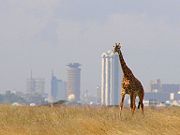
Nairobi is not a prime tourist destination, but it does have several tourist attractions. The most famous is the Nairobi National Park. The national park is unique, in being the only game-reserve of this nature to border a capital city, or city of this size. The park contains many animals including lions and giraffes. The park is home to over 400 species of bird,.
Nairobi is home to several museums. The National Museum of Kenya is the largest in the city. It houses a large collection of artefacts, including the full remains of a homo erectus boy. Other prominent museums include the Nairobi Railway Museum and the Karen Blixen Museum.
Nairobi is nicknamed the Safari Capital of the World, and has many spectacular hotels to cater for safari-bound tourists. Five star hotels in Nairobi include the Nairobi Serena, Grand Regency, Windsor (Karen), Holiday Inn, East African Safari Club (Lilian Towers), The Stanley Hotel, Safari Park & Casino, InterContinental, Panari Hotel, Hilton, and the Norfolk Hotel.
Nairobi is also home to the largest ice rink in Africa: the Solar Ice Rink at the Panari Sky Centre. The rink, opened in 2005, covers 15,000 square feet (1,400 m²) and can accommodate 200 people.
Other notable sites include Jomo Kenyatta's mausoleum, Kenya National Theatre and the Kenya National Archives. Art galleries in Nairobi include the Rahimtulla Museum of Modern Art (Ramoma) and the Mzizi Arts Centre.
Places of interest
- Nairobi National Park
- Karen Blixen Museum
- Bomas of Kenya
- Giraffe Centre
- Safari park
Transport
Airports
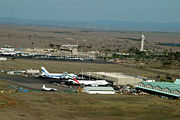
Nairobi is served primarily by Jomo Kenyatta International Airport. It is the largest airport in East and Central Africa. and handled over 4.4 million passengers in 2006. The airport is a major transit hub for passengers flying to East Africa's natural attractions, and other smaller cities in East and Central Africa. The airport is situated 20km from Nairobi's Central Business District, and is served by taxis, shuttle services and coaches. The airport directly serves intercontinental passengers from Europe and Asia.
Wilson Airport is a small, busy airport to the south of Nairobi. It handles small aircraft that generally operate within Kenya, although some offer services to other East African destinations.
Eastleigh Airport was the original landing strip in the pre- jet airline era. It was used in a landing point on the 1930s and 1940s British passenger and mail route from Southampton to Cape Town. This route was served by flying boats between Britain and Kisumu and then by land-based aircraft on the routes to the south. The airport is now a military base.
Buses
Buses are the most common form of public transport in Nairobi. Matatus, privately owned minibuses, are the most popular form of local transport, and generally seat fourteen to twenty-four. Matatus operate within Nairobi and from Nairobi to other towns. The matatu's destination is imprinted on the side of the bus. Matatus plying specific routes have specific route numbers. Matatus were easily distinguishable by their extravagant paint schemes. Owners would paint their matatu with their favourite football team or hip hop artist. They were notorious for their poor safety records, which was a result of overcrowding and reckless driving. Matatu drivers were pressured to make as many round trips as possible to maximize profits for their operator. They are very popular within the city. Most are equipped with high music systems which attract customers as competition is very high between matatus. The more round trips with the more customers basically means more money for the workers and the owners.
However, in 2004 a law was passed in which all matatus had to include seat-belts, speed governors, and all be painted in a uniform white with yellow band across it. At first, this caused a furore amongst matatu operators, but they were pressured by government and public to make the changes. Matatus are now limited to 80 km/h.
Citi Hoppa is the newest bus fleet operating in Nairobi. Run privately, the Citi Hoppa offer relatively modern buses on many routes within the city. The Citi Hoppa buses are distinguishable by their green livery. It is now the leading bus operator in Nairobi, after Bustrack fell along with its mother company, Kenya Bus Services.
Railways
Nairobi was founded as a railway town, and the Kenya Railways (KR) main headquarters are still situated there, near the city centre. The line runs through Nairobi, from Mombasa to Kampala. Its main use is freight traffic, but regular nightly passenger trains connect Mombasa, Nairobi and Kisumu. A number of morning and evening commuter trains connect the centre with the suburbs, but the city has no proper light rail, tramway or subway lines. A JKI airport shuttle rail service is being contemplated.
Nairobi is also the junction for a branch railway to Nanyuki.
Housing
There are wide variety of standards of living in Nairobi. Most wealthy Kenyans live in Nairobi but the majority of Nairobians are poor. Half of the population have been estimated to live in slums which cover just 5% of the city area. The growth of these slums is a result of urbanization, poor town planning and the unavailability of loans for low income earners.
Kibera is the one of the largest slums in Africa, and is situated to the west of Nairobi. ("Kibera" is the Nubian word for "forest"). The slums cover two square kilometres and is on government land. Kibera has been the setting for several films, the most recent being The Constant Gardener.
Other notable slums include Mathare and Korogocho. Altogether, 66 areas are counted as slums within Nairobi.
Many Nairobi non slum-dwellers live in relatively good housing conditions. Large houses can be found in many neighbourhoods, especially to the west of Nairobi. Historically, British immigrants have settled in Langata and Karen. Other middle and high income estates include Parklands, Westlands, Hurlingham, Milimani and Nairobi Hill.
To accommodate the growing middle class, many new apartments and housing developments are being built in and around the city. The most notable development is Greenpark, at Athi River town, 25 km from Nairobi's CBD. Over 5,000 houses, villas and apartments are being constructed at this development, including leisure, retail and commercial facilities. The development is being marketed at families, as are most others within the city.
Population
Nairobi has experienced some of the highest growth rates of any city in Africa. Since its foundation in 1899, Nairobi has grown to become the largest city in East Africa, despite being the youngest large city in the region. The growth rate of Nairobi is currently 6.9%. It is estimated that Nairobi's population will reach 5 million in 2015.
| Year | Population |
|---|---|
| 1906 | 11,500 |
| 1911 | 14,000 |
| 1921 | 24,300 |
| 1926 | 29,900 |
| 1929 | 32,900 |
| 1931 | 47,800 |
| 1939 | 61,300 |
| 1944 | 108,900 |
| 1948 | 119,000 |
| 1955 | 186,000 |
| 1957 | 221,700 |
| 1960 | 251,000 |
| 1962 | 266,800 |
| 1965 | 380,000 |
| 1969 | 509,300 |
| 1979 | 827,775 |
| 1989 | 1,324,570 |
| 1995 | 1,810,000 |
| 1999 | 2,143,254 |
| 2005 | 2,750,561 |
Crime
Throughout the 1990s, Nairobi had struggled with rising crime, earning a reputation for being a dangerous city and the nickname "Nairobbery". In 2001, the United Nations International Civil Service Commission rated Nairobi as among the most insecure cities in the world, classifying the city as "status C." The head of one development agency cited the "notoriously high levels of violent armed robberies, burglaries and carjackings. Crime had risen in Nairobi as a result of urbanization. As a security precaution, most large houses have a watch guard, burglar grills, and dogs to patrol their grounds during the night. Most though occur around the poor neighborhoods where it gets dangerous during night hours.
Crime has since decreased in the city, due to increased security and an improved police presence. The government has taken measures to combat crime with heavy police presence in and around the city. The government further announced its intention to employ over 20,000 new police officers to boost its war on criminal and gang activities in the country.
Universities
Nairobi is home to several universities.
- The University of Nairobi is the oldest university in Kenya. It was established in 1956, as part of the University of East Africa, but became an independent university in 1970. The university has approximately 22,000 students.
- Kenyatta University is situated 23km from the centre of Nairobi, on over 1,000 acres (4.0 km²) of land. The university was established in 1985 after a long struggle for the status, which started in 1963.
- Strathmore University started in 1961 as an Advanced Level (UK) Sixth Form College offering Science and Arts subjects. The college started to admit accountancy students in March 1966, and thus became a university. In January 1993 Strathmore College merged with Kianda College and moved to Ole Sangale Road, Madaraka Estate, Nairobi.
- United States International University - Nairobi is a branch of the United States International University, which has campuses across the world. The Nairobi campus was established in 1969, with the first graduation taking place in 1979. The university has accreditation from the Western Association of Schools and Colleges, in USA and the Government of Kenya.
- Daystar University is a Christian liberal arts university located in Athi River, south-east of Nairobi.
- In 2005, The Aga Khan Hospital, Nairobi was upgraded as the only teaching hospital in East Africa, providing post graduate education in medicine and surgery including nursing education.
- The Catholic University of Eastern Africa - In 1989, the Institute obtained the "Letter of Interim Authority" as the first step towards its establishment as a private university. After three years of intensive negotiations between the Authority of the Graduate School of Theology (CHIEA) and the Commission for Higher Education, the Faculty of Arts and Social Sciences was established. The climax of the negotiations was a granting of the Civil Charter to CHIEA on 3 November 1992. This marked the birth of the university as a private institution.
- Africa Nazarene University- located in Ongata Rongai, it's just minutes from the Kenyan capital Nairobi. Africa Nazarene University is a private chartered Christian university sponsored by the Church of the Nazarene International and it is a member of the worldwide family of Nazarene institutions. The mission of Africa Nazarene University is to provide a holistic education that develops individuals academically, spiritually, culturally and physically to equip them with excellent skills, competencies and Christian values which will enable them to go into the world well prepared to meet the challenges of their time.
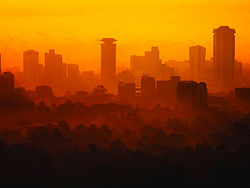

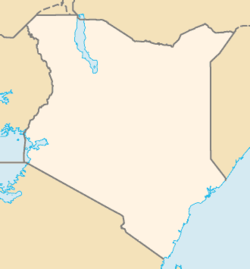
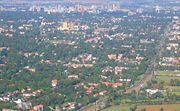
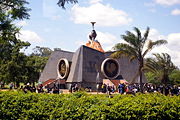
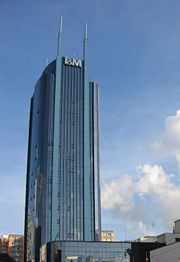
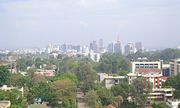

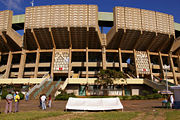

![A typical[citation needed] Nairobi residential suburb, with the Central Business District in the distance.](../../images/727/72779.jpg)
